Hiroshi Yagi was driving through the Chichibu Tama Kai National Park when the animal came up from the stream on his left, passed in front of him and stopped about two metres (6.5ft) away from his car. It showed no fear as he edged towards it, firing off several photographs. The creature was apparently unfazed by the presence of a human. Either it was comfortable being around humans, or felt unthreatened because of its status as the apex predator in this habitat.
“This was 23 years ago, and I didn’t have much technical knowledge then,” says Yagi. “But I thought, ‘This must be a wolf’.”
Yagi, a keen mountaineer, spends a lot of time in the mountains around Chichibu in central Japan, but this was the first time he had come face to face with an animal he had spent the best part of his life searching for.
“I decided I would try and give him an osenbei (a rice cracker) and put out my hand and offered it to him,” says Yagi. “I am right-handed, so I offered the cracker to him in my left, thinking that even if he bit my left arm, I would be alright.”
“He was right in front of me at this point. I had brought the rice cracker right under his mouth. But he didn’t take it. He just stood there. I tried to see if he smelled like a wild animal, but he didn’t. He had no smell. And just like a new-born baby, he had no knowledge or fear of danger.”
Wolves have been extinct in Japan for at least 100 years, according to scientific records. The last known Japanese wolf remains were bought by a zoologist in 1905 who sent the pelt to the Natural History Museum, London.
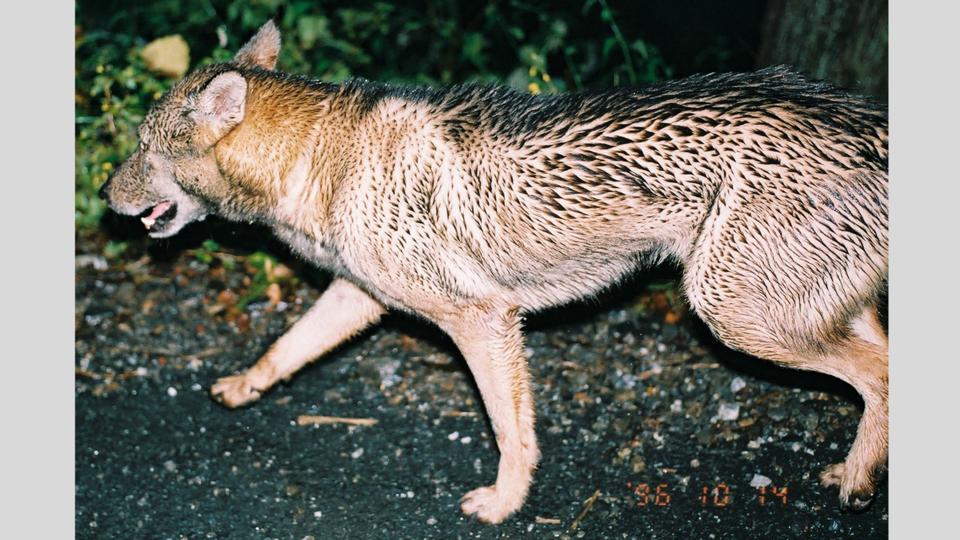
One of the 19 photographs Yagi took of the wolf-like animal that confronted him in 1996 (Credit: Hiroshi Yagi)
The discoveries of bones, fur and scat, which all appear to date from before 1905, makes the likelihood that Yagi saw a living Japanese wolf that October night seem remote. Why was Yagi so convinced that he had encountered a wolf? Because he, like many other people in rural Japan, it would transpire, had heard the telltale sign of wolves in the night many years earlier.
Local reports
Yagi’s pursuit of the Japanese wolf began about 20 years before his sighting in 1996. He was on night watch duty at a mountain lodge that was owned by a mountaineering group he was part of.
“It was then when I heard a howl,” says Yagi. “I knew that the Japanese wolf had been declared extinct since the Meji era [which ended in 1912], but I thought, ‘An animal that doesn’t exist can’t howl’.” And so began his 50-year search for the Japanese wolf.
The photographs he captured on that night as he crept to within an arm’s length of what could have been a living relic ignited the imaginations of local Chichibu residents after they were examined by a prominent Japanese zoologist who described the animal as ‘extremely wolf-like’, without conclusively saying the animal was an extinct wolf. While many academics remained sceptical about their existence, some experts concluded that the animals in Yagi’s photos closely resembled the Japanese wolf. The animal became known as the “Chichibu yaken” (or the Chichibu “wild dog”).
Soon, other Japanese residents began coming forward with similar stories.
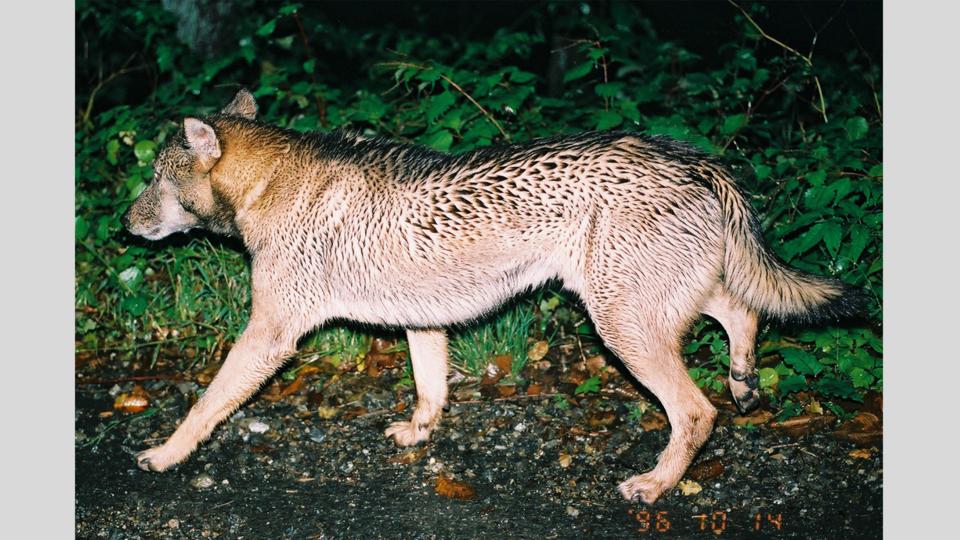
Without conclusive evidence that the animal Yagi saw was a Japanese wolf, the creature became known as the Chichibu “wild dog” (Credit: Hiroshi Yagi)
“My mother told me that her friend in Chichibu – a lady in her 50s – claims to have seen a wolf-like animal in her garden back in December,” says Alex Martin, an American-Japanese journalist who has started his own search after hearing Yagi’s story. “There have been numerous accounts of sightings, reports of howling and discoveries of purported wolf bones, droppings and fur that have led some to believe that the animal may still be alive and roaming the mountains of Japan.”
There have been numerous accounts of sightings, reports of howling and discoveries of purported wolf bones, droppings and fur – Alex Martin
The Japanese wolf is often portrayed in literature and folklore as a “mystical” animal, in the words of Martin. The specific name of the Japanese wolf, hodophilax, translates as “pathway guardian” in reference to the Japanese legend of “okuri-okami”, the “sending wolf” or “escorting wolf” who followed travellers on mountain trails and guarded them during their journey. Other versions of the folklore tell of okuri-okami who attack travellers who fall or who do not act respectfully towards the wolves.
What is likely is that the legends are borne from the real behaviour of wolves, who might stalk prey for many kilometres before attacking them, giving the impression they are protecting travellers, when in fact they are hunting.

The great white wolf goddess, Moro, from the animated film Princess Mononoke is based on the legend of the Mitsumine Shrine (Credit: Alamy)
The Japanese wolf is worshipped in Japan, and is particularly revered in Chichibu where many shrines pay tribute to the animals. One such shrine, Mitsumine Shrine, is said to have been founded by a prince, who after becoming lost in the mists of the Okuchichibu mountain range while on a mission to subdue a warring tribe, was guided to safety by a great white wolf.
Modern Japanese arts and literature also pay reference to the wolves. The animated film Princess Mononoke (1997), which is said to be based on the legend of the Mitsumine Shrine, features a great white wolf goddess that raises a human child called San, played by Yuriko Ishida in Japan and Claire Danes in the English version, who becomes one of the film’s protagonists.
“Personally, I’ve discovered that researching this animal involves various aspects – not only science, but folklore, history, religion and much more – things that help paint a vivid picture of how superstition and legends were very much a part of everyday life in pre-modern Japan,” says Martin.
The amateur search
Due to the swelling popularity of Yagi’s research, the intrepid researcher is now supported in his search by about 20 other individuals – all amateurs – five or six of whom are regularly active.
“When the pictures were made public, many other people came forward to share their stories of wolf cries or sightings,” says Yagi. “It was this kinship, that we were not alone in our belief in what we have seen and heard, that has brought together this search, and now a bit of traction. It has to be this personal connection with the wolf, that inspires this belief in the wolf’s existence. And together we want to bring out the truth.”
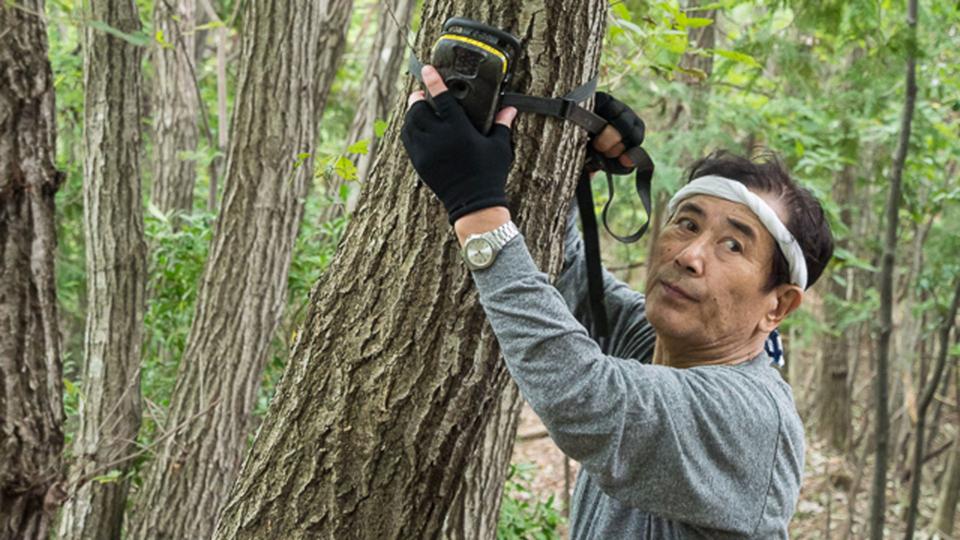
Yagi has set up 70 infra-red camera traps across the Okuchichibu mountains to find more proof (Credit: Hiroshi Yagi)
But Yagi acknowledges that the photographs he took 23 years ago are not the definitive proof he needs.
Now, the search is turning to modern technology to help capture further proof, including about 70 motion-sensitive infra-red video cameras set up across the Okuchichibu mountains. About a year ago, they recorded footage of three deer running past one of these camera. At first it seemed little to be excited about, but on closer inspection, Yagi noticed the audio accompanying the images appears to have picked up the sound of a howl.
“We brought the recorded howl to a specialist, and he compared it to that of the Eastern wolf that was kept at Asahikawa Zoo in Hokkaido,” says Yagi. “He declared with 99.5% assurance that the two were of the same animal, and I have received a certificate of authenticity for the wolf recording.”
WATCH
Hiroshi Yagi’s wolf howl recording
The supposed howl of a Japanese wolf can be heard in this short clip. You might need to wear headphones to hear it clearly.
“When I first heard the howl 50 years ago, I had told many people that I believed it was the wolf,” says Yagi. “But their logic was that ‘If it doesn’t exist, it can’t be’. Whereas I believe in its opposite – if it is, then it exists. And it is this disbelief in other people, its this idea to disprove their logic, that has driven me this far. Sometimes it does seem like the road is still long.”
‘Lazarus’ species
Historically, the IUCN used the “50-year rule” to determine whether a species or subspecies is extinct, although it has now been replaced by a more nuanced species-specific approach, which requires evidence to be collected from targeted surveys across a species’ range before extinction can be determined. The reality is that for some species, which are widely tracked and extensively researched, 50 years without observation is an unnecessarily long time.
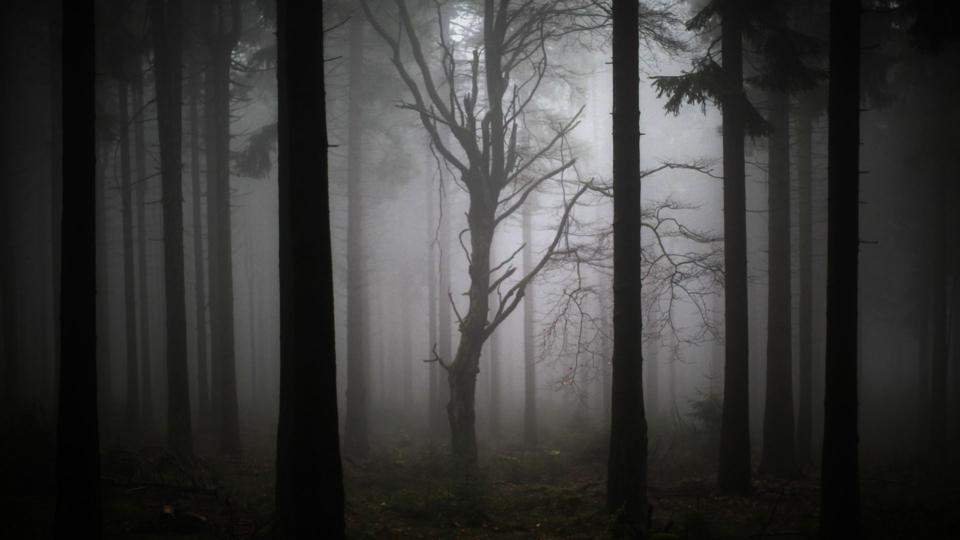
In the most remote environments, reports from locals are some of the best data scientists can work from (Credit: Getty Images)
For others there might have been so few sightings of the animals in the first place it would be an arbitrarily unfair rule. “No Western scientists have ever seen a wild saola – a beautiful long-horned Asian forest antelope, which is one of the world’s rarest mammals,” says Samuel Turvey from the Zoological Society of London’s Institute of Zoology. “Information about its distribution in Vietnam and Laos is based largely on anecdotal reports by local hunters and villagers.” In the case of the saola, a handful of photos are the most that Western scientists have seen, so the 50-year rule is obsolete.
“In some cases, possibly extinct species might occur in extremely remote and impenetrable landscapes which are rarely visited by researchers, and so their status remains unknown rather than necessarily extinct,” says Turvey. “The complexity of proving extinction is made more difficult by the theoretical challenges that you can’t prove a negative… just because you don’t find a species, does this just mean that you haven’t looked hard enough, or in the right place or at the right time of year, rather than necessarily meaning it no longer exists?”
Turvey warns that in the absence of definite accepted sightings in over a century, the continued survival of the Japanese wolf is unlikely, but not necessarily impossible.
“Making its survival less likely is the fact that wolves are social animals, which live in groups and make loud howling calls, which would be expected to make them more easily detectable compared to a solitary silent animal if they were still present in a landscape,” says Turvey.
“This brings us onto the sticky issue of data quantity versus data quality. Sightings have been reported which post-date the last ‘definite’ record, but they’re unverified and probably unverifiable, so we can’t be sure what was actually seen. This is the same confusing situation faced by scientists when trying to determine the possible survival of other ‘officially’ extinct species such as the thylacine and ivory-billed woodpecker.”
Reports made by local people who live in the same landscapes as possibly extinct species definitely shouldn’t be dismissed – Samuel Turvey
Some enthusiasts still believe that the thylacine, more commonly known as the Tasmanian tiger, still exists. One group of amateur sleuths have been using camera traps in the southern Tasmanian forests to find evidence of its existence, and in 2017 released a video purporting to show the animal, although the quality of the recording is anything but conclusive.
“Reports made by local people who live in the same landscapes as possibly extinct species definitely shouldn’t be dismissed,” says Turvey. “Often such reports represent the only source of information about rare animals across large areas of remote habitat, which would require huge amounts of funding to survey using standard ecological approaches.”
Living things that appear to return from extinction are dubbed “Lazarus” species. Perhaps the most famous example of which is the coelacanth, a species of fish that has remained unchanged for millions of years and until 1938 was only known from fossil records before a living example was found off the South African coast. There are thought to only be a few hundred coelacanths left in the world. But their natural habitat, in deep waters may explain why they remained undetected for so long.
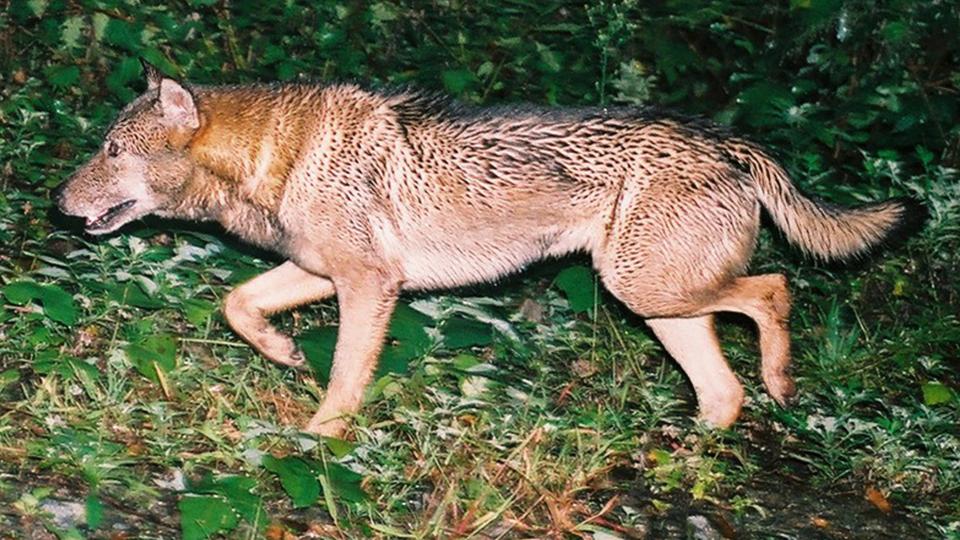
Smaller than you might imagine, the Japanese subspecies was similar in size and colouration to the living Mongolian or Tibetan wolf (Credit: Hiroshi Yagi)
One sure way to put to bed the debate about whether the Japanese wolf really is still roaming wild in the mountains of Chichibu would be to obtain DNA evidence. This, far more than any number of photographs and recordings, could conclusively prove that the sightings are of wolves rather than domesticated dogs turned wild.
But there is another possibility. Wolves are able to successfully breed with domesticated dogs and produce fertile offspring, so there is a chance the population survived beyond the date of their presumed extinction by hybridising with local pets. A hybrid wolf-dog might explain the small, docile wolf-like animal Yagi saw 23 years ago. Although, in reality, the crossover between wolves and pet dogs would be so infrequent that a stable population would be unlikely to survive. Many large, domesticated dogs are also able to produce a wolf-like howl – so, stray pets which have ventured into the mountains might explain the noises locals heard.
Systematic collection and analysis of reported wolf sightings made by local people would be a very important next step to see what sort of patterns these reports might show in terms of distribution, says Turvey. Yagi agrees. If they find more evidence from their 70 remote cameras, they might better determine where to set up a harmless trap in order to capture one for DNA tests.
I’m inclined to believe that something is out there in the mountains – Alex Martin
“I believe I have been pure and passionate about finding the wolf, which is why I have been blessed with a sighting,” says Yagi. “I do believe I have been chosen by God to find and prove the existence of the Japanese wolf. Unfortunately there are nay-sayers, and I keep thinking ‘Get off the desk! Come and look for them in the mountain’.”
He is determined to keep patiently work towards his goal.
“Personally, I’m inclined to believe that something is out there in the mountains, whether it be the extinct animal itself or its descendants, and that sufficient time, money and technology will be able to reveal what it is,” says Martin, who will continue his own research having been inspired by Yagi. He has already had a new lead.
“Two weeks ago my mother informed me that she heard a series of unusual howls from the forest behind her Chichibu home, prompting me to set up infrared trail cameras in the area,” says Martin. “I’m waiting to see what I find.”